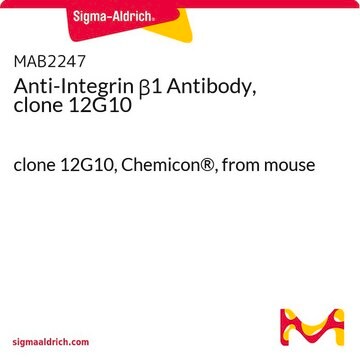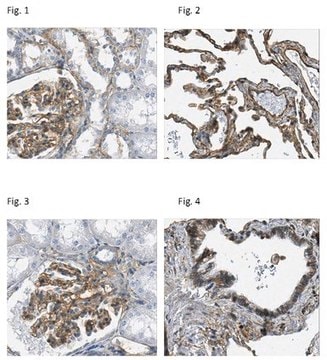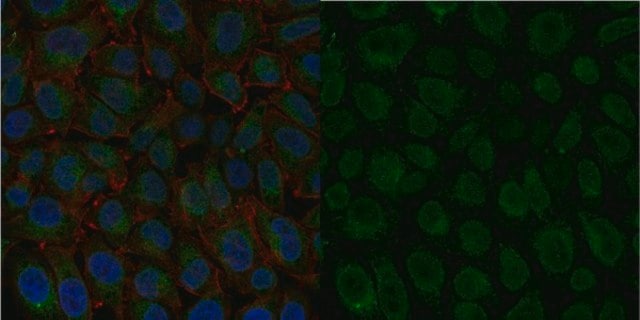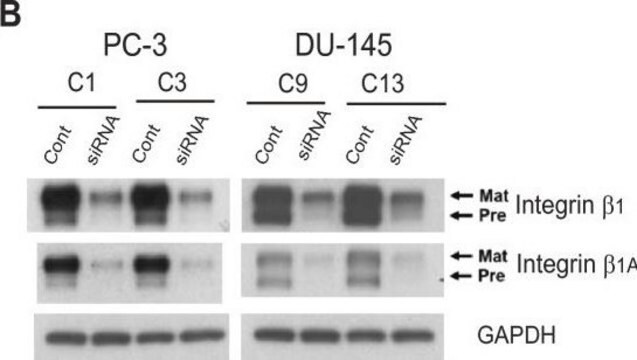MAB1997
Anti-Integrin β1 Antibody, clone MB1.2
clone MB1.2, Chemicon®, from rat
Sinonimo/i:
CD29 antigen, Fibronectin receptor subunit beta, Integrin VLA-4 subunit beta, fibronectin receptor beta subunit, integrin VLA-4 beta subunit, integrin beta 1, integrin beta 1 (fibronectin receptor, beta polypeptide, antigen CD29 includes MDF2, MSK12)
About This Item
Prodotti consigliati
Origine biologica
rat
Livello qualitativo
Forma dell’anticorpo
purified immunoglobulin
Tipo di anticorpo
primary antibodies
Clone
MB1.2, monoclonal
Reattività contro le specie
mouse, human
Reattività contro le specie (prevista in base all’omologia)
rat
Confezionamento
antibody small pack of 25 μg
Produttore/marchio commerciale
Chemicon®
tecniche
flow cytometry: suitable
immunohistochemistry: suitable
immunoprecipitation (IP): suitable
western blot: suitable
Isotipo
IgG2κ
N° accesso NCBI
N° accesso UniProt
Condizioni di spedizione
ambient
Temperatura di conservazione
2-8°C
modifica post-traduzionali bersaglio
unmodified
Informazioni sul gene
human ... ITGB1(3688)
Descrizione generale
Specificità
Immunogeno
Applicazioni
A previous lot of this anitbody was used to immunoprecipitate VLA (β1) integrins from lysate of 106 cell equivalent: 2 μg.
Flow cytometry:
A 10 μg/mL concentration of a previous lot was used in FC.
Immunohistochemistry in frozen tissue sections:
20 μg/mL from a previous lot was used. As a result of the wide tissue distribution of VLA (β1), binding of MAB1997 to diverse cell types is commonly observed.
Does not block VLA integrin mediated cell adhesion to matrix proteins. Activation of VLA (β1) integrin signaling properties by MAB1997 has not been characterized.
Western blot:
10 µg/mL. Effective for samples that have been SDS-denatured and heated. Not effective for reduced samples.
Optimal working dilutions must be determined by end user.
Qualità
Western Blot Analysis:
1:1000 dilution of this lot detected integrin β1 on 10 μg of C2C12 lysate.
Descrizione del bersaglio
Linkage
Stato fisico
Risultati analitici
Human OVCAR5 cell line whole cell lysate
C2C12 lysate.
Altre note
Note legali
Not finding the right product?
Try our Motore di ricerca dei prodotti.
Raccomandato
Codice della classe di stoccaggio
12 - Non Combustible Liquids
Classe di pericolosità dell'acqua (WGK)
WGK 2
Punto d’infiammabilità (°F)
Not applicable
Punto d’infiammabilità (°C)
Not applicable
Certificati d'analisi (COA)
Cerca il Certificati d'analisi (COA) digitando il numero di lotto/batch corrispondente. I numeri di lotto o di batch sono stampati sull'etichetta dei prodotti dopo la parola ‘Lotto’ o ‘Batch’.
Possiedi già questo prodotto?
I documenti relativi ai prodotti acquistati recentemente sono disponibili nell’Archivio dei documenti.
Il team dei nostri ricercatori vanta grande esperienza in tutte le aree della ricerca quali Life Science, scienza dei materiali, sintesi chimica, cromatografia, discipline analitiche, ecc..
Contatta l'Assistenza Tecnica.







